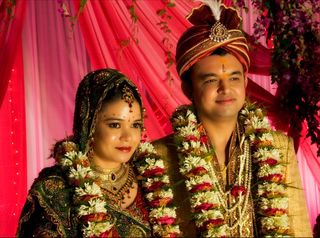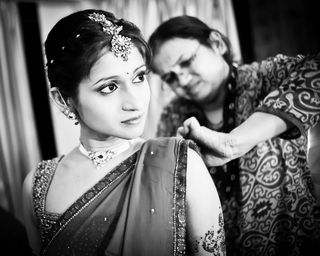Marriage
Why Are So Many Indian Arranged Marriages Successful?
Relinquishing choice, deciding quickly, and lowering expectations helps.
Posted November 24, 2015 Reviewed by Ekua Hagan
Key points
- Thinking too much about one's options, such as in free-choice dating and marriage, can produce regret about having lost out on others.
- In many Indian arranged marriages, expectations are low and are often met or exceeded. With free-choice marriages, the opposite is often true.
- When left to their own devices, people tend to emphasize external factors (looks, possessions, etc.) when choosing a mate.

During my two-plus decades living in the United States, I have seen many changes occur in my native India. The country eradicated the scourge of polio, sent a rocket ship to Mars on a shoestring budget, built modern highways crisscrossing the country, and flexed its economic muscles, raising tens of millions of people out of poverty.
One phenomenon that hasn’t changed, however, and continues to puzzle and intrigue many people (including me) is the institution of the Indian arranged marriage. Even today, a vast majority of Indians and Indian Americans that I know, including family members, friends, acquaintances, and my students, many of them among the highest educated and Westernized strata, choose an arranged marriage over a free-choice one.
How Does a Modern Indian Arranged Marriage Work?
A typical modern arranged marriage works as follows. For both men and women, the individual’s parents or older family members screen for and find prospective mates for further consideration through their social circle, community, or by advertising on matrimonial websites or newspapers.
There is an initial meeting in a family gathering, after which the couple has a few opportunities for chaperoned courtship. At this point, if neither party has vetoed the match and if they are so inclined, they may spend some time together alone.
Then, it is time to make the decision. It is not unusual for the process from the initial introduction to the final yes/no decision to unfold within a few days. A 2013 IPSOS survey found that 74 percent of young Indians (18-35 years old) prefer an arranged marriage over a free-choice one. Other sources report that as many as 90 percent of all Indian marriages are arranged.
In this post, I want to explore two rather interesting and reliable statistics related to Indian arranged marriages. The first is that Indians have an astonishingly low divorce rate. Despite doubling in urban areas since 2007[1], only about 1 in 100 Indian marriages end in divorce.[2] This is one of the lowest divorce rates in the world. Even more impressive is the second statistic, about the high levels of satisfaction reported by those in arranged marriages over the longer term.
A recent study of relationship outcomes among Indian-American couples married either through free-choice or arranged marriages for about a decade found absolutely no differences. Those in arranged marriages were just as satisfied with their marriage and loved their partner as intensely as those who wed through free choice. Other studies have found similar results. Despite criticisms of self-selection and small sample sizes leveled against some of these studies, this is the best available evidence and it suggests that Indian arranged marriages are at least as successful as free-choice ones.
How can this be? How can two people who barely know each other make such an important decision that will affect their joint futures so quickly? And even more surprising, how can a decision made this way lead to positive outcomes for so many couples?
I want to propose three factors that might help explain this puzzle. These have to do with relinquishing difficult aspects of the choice, choosing with relatively little deliberation, and starting the relationship with lower expectations. Let’s look at each of these factors in detail.
Relinquishing Difficult Aspects of the Choice
From a decision-making perspective, choosing a marriage partner through arrangement has at least two major advantages. The first is that people who one respects and trusts—parents or elders—prescreen the available options, leaving a small and manageable choice set.

In free-choice marriage decisions, one of the hardest challenges is finding a good set of options to choose from. From those interested in marriage, complaints about how hard it is to find a good man or a good woman are commonplace. Just as problematic, when left to their own devices, people tend to use prescreening criteria that emphasize external factors (looks, possessions, etc.). These are short-term oriented and may not necessarily contribute to longer-term marital outcomes. For instance, social psychologists have found impressive evidence for “attractiveness matching” in which daters give heavy weight to physical attractiveness of potential partners, and favor those whose attractiveness is comparable to their own.
A second difficult challenge is the choice set size. The question of how many potential partners to date before marrying someone can be answered by math (the answer is the square root of n, where n is potential lifetime dates, the solution to the “optimal stopping problem”) or computation (made famous by the big data-driven process used by mathematician Chris McKinlay on OKCupid).[3] But for most people, it is difficult to figure out when to stop searching and just as hard not to begin again once they have settled for a chosen partner.
When a marriage is arranged, both these problems are solved. Prospects come vetted. What is more, they share many characteristics such as social class, religion, caste (yes, even today, for Hindus), and educational attainment that signal similarity and may be important predictors of longer-term marriage success. The vetting process also limits the choice set size and puts a grinding halt to further search once a choice is made. Making others you trust do all the hard work in the choice process pays off.
Choice With Relatively Little Deliberation
The conventional wisdom about decision-making is that the more time and effort we spend in making a decision, especially for important issues, the better our decision will be and the happier we will be with the outcome. But this is not always the case.
There is a whole body of research that points to the exact opposite conclusion. It shows that for complex decisions, people are better served by not thinking too much and relying more on gut feelings. In one study of IKEA furniture shoppers, for example, researchers found that those who thought less about which furniture to buy were happier with it a few weeks later.
Another negative consequence of thinking too hard about different options is that people get attached to them, so choosing one option produces regret about having lost out on others (what psychologists call the “choosing feels like losing” effect). Nowhere is this truer than in dating and marriage decisions, where potential partners may have different attractive qualities, and none may have all the qualities one is looking for.
My hunch is that what applies to IKEA furniture also applies to choosing a husband or a wife. In an arranged marriage, the speed with which one must decide whether or not to marry the person they have been introduced to doesn’t leave much time for careful thinking or comparisons. Instead, it encourages going with one’s gut feelings about the partner, which in turn may lead to more satisfying outcomes. In free-choice marriages, on the other hand, the long and elaborate dating process provides lots of time and opportunity to judge potential partners critically and deliberately, and long for the ones that got away.
Starting the Relationship With Lower Expectations

A third reason for positive outcomes in arranged marriages is the expectation level of participants. By and large, a couple entering an arranged marriage simply doesn’t know each other that well compared to those beginning free-choice marriages. Consequently, the expectations of each other at the relationship’s outset will be lower. This is because in-depth knowledge is crucial to forming accurate expectations, and more knowledge produces higher expectations. In Indian arranged marriages, in particular, many people give greater weight to compatibility and financial security over romantic love, further contributing to restrained expectations.[4] As research on satisfaction judgments shows, when expectations are low, they are more likely to be met or exceeded, leaving the newlyweds highly satisfied. In a free-choice marriage, in contrast, high expectations often develop during an elaborate dating period, with the culture placing great weight on the romantic love ideal. This sets people up for a letdown after the honeymoon period is over.
The Indian Arranged Marriage Puzzle in Cultural Context
A terrific amount has been written about Indian arranged marriages, of course. While I focused on the reasons why some aspects of its decision-making process favor positive longer-term outcomes, I certainly don’t mean to suggest that this is a superior method of finding someone to marry.
Rather, I see the positive outcomes as a puzzle. There are many important aspects of arranged marriage that I didn’t discuss, such as its roots, supports, and long history in Indian culture that make it socially acceptable. But just as there are heartwarming success stories about marriages between strangers leading to lasting love, there are stories of exploitation and suffering of women. One could easily write a lengthy dissertation examining the negative aspects of Indian arranged marriages.
If you have a good or bad personal experience with an arranged marriage, please share your story in the comments. Let me know if you agree with this post or whether you think I am off the mark. And if you enjoyed this post, check out "How Do Indian Women Fare in an Arranged Marriage?" and "Ways to Prescreen Prospects for Indian Arranged Marriage."




